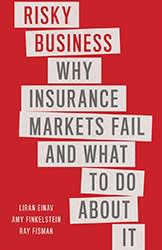Why insurance markets are a game of cat and mouse

Confusing, opaque and expensive. Buying and claiming on insurance policies can be a frustrating. It turns out, though, that insurance companies often feel the same way about their customers — a group of people whose inner secrets hold the key to their success or failure.
The reasons behind the mutual incomprehension lie at the heart of why many insurance markets either work badly, or do not work at all.

Where the book hits its stride is with some of the thornier problems insurance companies and their customers are beginning to face. Going back to health insurance, for example, the growing availability of genetic data leads to a new set of challenges as that information can be used to identify who is at higher risk of certain illnesses. Should governments allow insurers to use this information to price policies? If so, some people risk being excluded from the market because they lost the genetic lottery. But if insurers cannot use this information while their customers can, the market will be twisted in the other direction.
There are no easy answers here, and the authors do not try to offer any. There are, they say, only trade-offs. “Whatever balance between efficiency and fairness the government chooses, there will be winners and there will be losers,” they argue. “The losers will often have genuinely tragic stories to tell.”
These types of questions will become more common as insurers gather an ever wider range of data about their customers. The data may tell them, for example, that people with fair hair are more likely to drive too fast. Or that journalists who write book reviews are statistically more likely to have their house flooded. The information advantage could shift from the customer to the insurer, and the authors are a little too dismissive of the potential for big data to disrupt the market. But that potential is there. And it will not necessarily make insurance a less confusing, opaque or expensive place.
This story originally appeared on: Financial Times - Author:Oliver Ralph




























